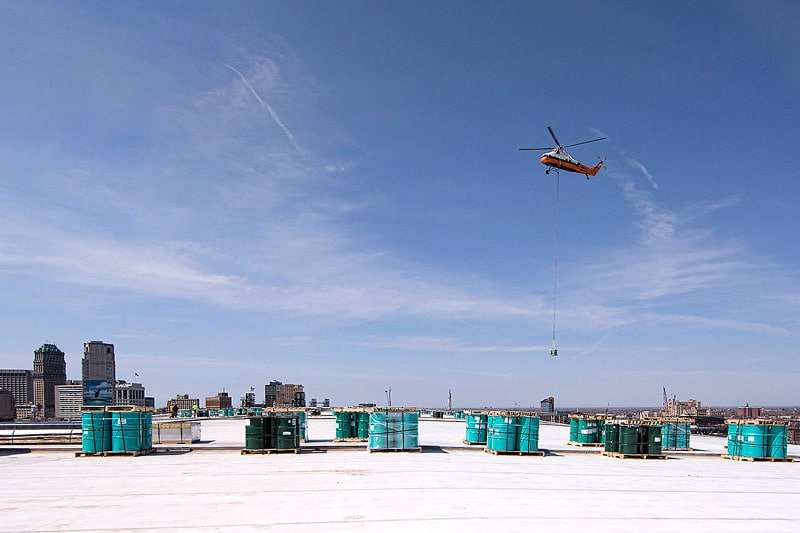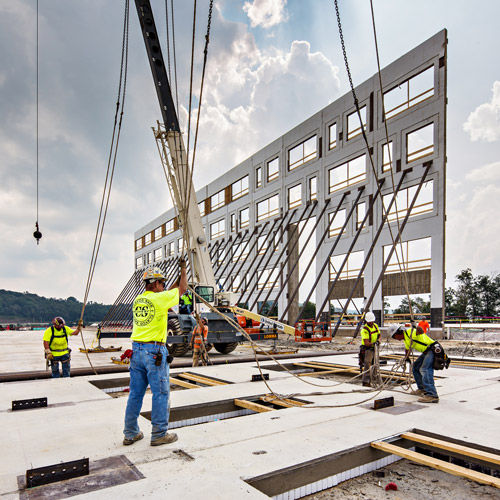
When you think of an NFL stadium, the first thing you think about probably isn’t changing the light bulbs. Fred Reddig does. As director of facilities at Ford Field for the Detroit Lions since 2014, Reddig, a LEED-accredited professional, oversaw a recently completed upgrade to the facility’s entire lighting system. He also oversaw roof renovations and planning for numerous other energy-saving and sustainable projects.
The lighting project began in 2015 when all day-to-day lights for maintenance and housekeeping were upgraded to LEDs. The savings that resulted from that relatively small-scale initiative prompted the decision to launch a complete overhaul of the stadium lights. The existing metal halide fixtures have all been replaced with Musco LED fixtures (including maintenance engineering LED phosphorous hybrids on the concourses). Savings are projected to amount to nearly 620,500 watts annually—or about $70 per hour of use.
Reddig says the upgrades are already paying for themselves: field lighting that cost approximately $1 million shows an ROI of four years; a new $200,000 light control system has an ROI of less than 12 months; and parking deck lights that reduced energy by 50 percent in the first month are projected to show ROI in 18 months. He also expects a total of $200,000 in energy rebates for 2016.
“Because of their greater efficiency, we only had to install 264 new fixtures to replace 660 old ones, and we’re still getting greater output at half of the energy costs we were paying before,” Reddig says.
The new lights also provide greater event flexibility. Once turned off, the old metal halide equipment had to cool for 15 minutes before being turned back on. Because the LEDs can be switched on again immediately, the fixtures will enable dramatic blackouts and reveals that were never before possible. The new system can also accommodate light-harvesting control, which uses photoelectric eyes to determine when additional lighting is needed to supplement natural light in the stadium’s 400,000 square feet of commercial space, as well as in the parking deck and perimeter.
From the Top Down
Also in 2016, thermal imaging of the dome roof at Ford Field revealed a small number of areas where heat escaped during the winter. Rather than waiting to do a complete roof replacement when the issue became more extensive, Reddig convinced executives to renovate the existing structure. A major part of his reasoning was that renovation would save 50 percent of the cost of waiting (estimated at about $4.5 million) and would provide the same warranty.
“Management was completely in favor of the cost-avoidance strategy of the roof renovation and it enabled us to take advantage of a number of economies of scale,” Reddig says. “Plus, our insurance company loved the idea that we were being proactive.”
Ford Field Does Battle
The Michigan Battle of the Buildings is an awards and recognition program for energy use reduction and sustainability for commercial and industrial buildings. Several hundred facilities participate statewide, but in 2016, Ford Field was in a mixed-use category with only eight other participants.
“We only ranked seventh, but also had eight more full stadium event days than the previous year and still used less power,” Reddig says. “It’s all part of our goal to become a better steward of the environment.”
Once all the factors were normalized for weather influences, Ford Field’s energy bills were approximately 8 percent lower than for 2015.
In addition to replacing insulation and adding a new, thicker, reflective PVC membrane (which qualified for utility incentives), the renovation includes several upgraded features. First, the membrane (Tremco Alpha-Guard) comes in a range of colors, so the Ford Field logo has been formed and integrated as part of the roof—not simply painted on like it was before. The stadium dome is also now illuminated for the first time, and colors can be customized to reflect holidays and other stadium events.
Get to Know the Building
Reddig’s first job as a supervisor came 15 years into his career when he was put in charge of Delphi’s corporate headquarters. After 20 years, he has learned a few key lessons.
“You have to be in tune with the building and get to know how it functions,” he says. “After I became a supervisor, I also learned pretty quickly that it’s much easier to work with people than to work against them.”
He also learned patience, citing one of his first experiences as a supervisor having to wait several hours for electricians to arrive before pipefitters could finish their job.
“I’ve been working with the trades, unions, inspectors, and architects for a long time since then, so we’ve been able to get to know each other and have figured out how to work together pretty well,” Reddig says.
As he manages other ongoing projects, such as changing the external air intake controls for improved efficiency, staging water pumps with variable speed controllers to meet real-time demand, and introducing water softeners into the cooling tower (which saved 300,000 gallons of water over the course of just one-third of the cooling season), Reddig never stops looking for ways to improve the stadium’s environmental footprint. He’s considering the possibility of adding a cistern to catch rain runoff from the roof and using it to irrigate the stadium’s green areas and lower its water bills. He says there’s no reason to stop brainstorming, either.
“At the end of the day, if we can come up with better solutions and in turn save energy, that just means our future generations will have so much more to look forward to,” he says. “I think I will always be on the lookout for new and improved solutions because technology is constantly changing. Besides, it keeps my mind fresh.”
 OFF THE FIELD
OFF THE FIELD
with Guest Editor Tom Ruscitti
TR: Most people you meet must think you have the best job in the world. Even though you most likely do, what is your humble reply?
FR: When I got hired I told my wife, “I finally have my dream job!” It truly is a dream job, but it also has a lot of challenges that I never considered. A lot goes on behind the scenes for every event, but we always make it happen.
TR: What technical skills serve you best for such an iconic and maintenance-intensive facility?
FR: I’m a LEED AP, which has helped me identify our energy deficiencies. I’m also licensed with the City of Detroit as a refrigeration journeyman, refrigeration operator, and boiler operator. The skills needed to be a good HVAC technician are varied with all aspects of plumbing, electrical, mechanical, and ductwork needed. These skills have definitely helped me in a 35-year career in building operations.
TR: If a facility such as Ford Field is not properly managed, it will negatively impact the enterprise’s bottom line. What do you and your team do to mitigate such a risk?
FR: My years in building management taught me that without a good infrastructure, the building will fail. My team takes a holistic approach and makes sure our electrical, mechanical, plumbing, life safety, and structural components are all maintained to industry standards. As we go through these components, we also look for energy-saving retrofits to lengthen the life while saving energy consumption.
TR: What techniques do you employ to motivate your team?
FR: I have a great team and enjoy working with them. I am often in the trenches with my staff and encourage questions, ideas, and suggestions. If we pulled off something that was really difficult or required a lot of hours to accomplish, I let them know they did a great job by treating them to a nice lunch or something along those lines.
TR: Given your expertise on Ford Field and this type of building, what recommendations would you make to designers of future similar types of facilities?
FR: The amount of daylight brought into the building is an asset in both aesthetics as well as maintenance. However, limiting the amount of different lighting fixtures in a facility would be highly beneficial. Stocking close to a hundred different bulb types is a maintenance nightmare. We are currently transitioning a lot of fixtures to LED to alleviate that problem in addition to taking advantage of energy savings.
TR: Did you go backstage at the Guns N’ Roses concert?
FR: I did! I do for every event before the show to go through life safety items with the fire marshal, as well as to coordinate with the concert crews. During a performance, however, I only go backstage if needed for house lighting cues.



 OFF THE FIELD
OFF THE FIELD

